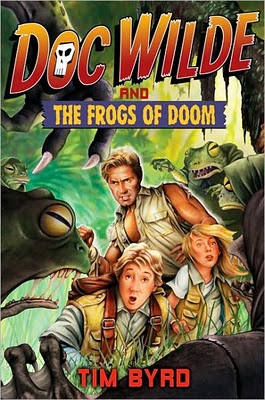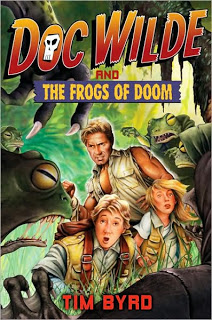SEAN ELLIS, Writer
AP: Tell us a little about yourself and your pulp interests..
SE: I think my bio starts by mentioning my “love affair with adventure.” That pretty much sums it up. For as long as I can remember, I’ve wanted to be an explorer/treasure hunter/action hero. Growing up, my idea of a good time was borrowing my dad’s machete and hacking through the blackberry vines at the edge of our property, in search of an imaginary Mayan temple or King Solomon’s Mines. Reading was a big part of that; when I was six years old, I read a book from the Danny Dunn science detective series and was hooked. After that I devoured all the Hardy Boys and Tom Swift books I could find. I’m not sure when wanting to write got added to the mix, but I suppose it’s a natural progression from playacting those characters in my daydreams to developing my own storytelling ability.
Watching Raiders of the Lost Ark was sort of like a religious experience for me. My imagination ran wild with possibilities for the character and eventually that turned into fan-fiction. I wrote something like a thousand pages of Indy stories, long hand. I’m not sure what ever became of those notebooks. I should check my parents’ attic….
I eventually discovered Clive Cussler’s Dirk Pitt series. The thing that really fascinated me about Cussler was how he divided his time between writing and looking for old shipwrecks and lost gold mines. When I learned that, I knew what I wanted to be when I grew up.
Cussler mentioned in an interview how he had been influenced by pulp adventures–Doc Savage, Sax Rohmer’s Fu Manchu, and so forth–and that was probably the first time I ever became aware of pulp stories, though looking back I can see that I had been reading them all along.
AP: What does pulp mean to you?
SE: I’ve called my Dodge Dalton novel a pulp-style or pulp-themed story. As a rule, I try to reserve the term “pulp” for the original fiction of the pulp magazines from the Depression era, much the same way wine snobs would demand that you have to call it “sparkling wine” if it’s not from Champagne, France. I’m not a pulp snob by any means; quite the opposite, I think the term is so broadly used that I’m not really sure where the line is drawn. I’ve seen the word ‘pulp’ attached to lot of mainstream fiction–Cussler, James Rollins, even Stephen King–and most of those authors wear it like a badge of honor. (James Rollins recently put the Doc Savage stories on his top ten list of favorite books). I suppose a better answer would be that I think of pulp as the genre that doesn’t quite fit with the others–westerns, science fiction, fantasy, mystery, etc.–but freely makes use of them all.
AP: Your pulp novels range from a Secret Agent X adventure, The Sea Wraiths to the wonderfully titled The Adventures of Dodge Dalton in In The Shadow Of Falcon’s Wings. Tell us a bit about the books and their pulp history.
SE: In 2005, as I was gradually becoming aware of hero pulps, I had the idea of creating a keystone character that would be the subject of a series of short (60-80,000 word) novels. My plan was to borrow a page from the old pulp model, by teaming up with some fellow aspiring authors and cranking out novels in rapid succession, not unlike what Charles Ardai has done with his Gabriel Hunt series. That was the genesis of the Dodge Dalton character. The first novel, is a sort of passing of the torch story. Dodge is a writer, chronicling the stories of Captain Zane Falcon, a Doc Savage-esque character. Falcon has been off the scene for many years, but when a crisis comes along, Dodge sets out with one of Falcon’s old sidekicks to hunt down the missing hero, and winds up more or less taking his place. I wrote that first novel over the course of a few months, and made a good start on the sequel, but everything else about my grand scheme failed completely. Over the years that followed, I pitched it to a couple different publishers, but none were as enthusiastic about the story as Kent Holloway from Seven Realms LLC. A quick aside: the novel was originally called Falcon’s Flight. There wasn’t anything wrong with that title, but when, on October 15, 2009 a young boy named Falcon Heene famously DIDN’T fly away in a homemade balloon, I decided I’d better come up with a new title. Kent and I talked it over and decided to go for a Buckaroo Banzai sort of vibe. So far, everyone I’ve talked to loves the new title.
Jump back to 2006, with Dodge languishing in obscurity, I packed up my laptop and went to war. I knew I’d have a lot of time to write, but I didn’t have a good story to tell. When you decide to write professionally, creative decisions become a bit more calculated; you don’t keep writing sequels to a novel that no one wants to publish, and I wasn’t making any headway in the publishing world. That was when my friend Wayne Skiver told me about his involvement with a planned series of anthologies based on classic pulp characters that were in the public domain. I was looking for a change of pace, something that might give me some visibility and add some publishing credits to my resume, so I contacted the editor of the anthologies (All Pulp’s own Ron Fortier) and asked to be involved. Secret Agent X was the only character I really identified with, mostly because I thought it would give a chance to write a James Bond-style character. At the time I had never read any of the original “Brant House” stories. When I started researching the character, I discovered X was more of a crime fighting vigilante than a Bond-style secret agent, so I had to rethink my original premise a bit to make it fit the canon. The original series ended before the outbreak of World War II, so as I was working on the short stories, I kept thinking about how the character might have transitioned from crime fighter to international super-spy during the war years. The Sea Wraiths was my attempt to make that transition. In the story, I send him overseas, literally into the lion’s den, to uncover a Nazi plot to take over America.
As luck would have it, my experiment with public domain pulp characters didn’t really open any doors, but it did keep me writing. About the time I was wrapping up The Sea Wraiths, I found a publisher for The Shroud of Heaven, so my focus returned to contemporary fiction.
AP: Who is Nick Kismet?
SE: Nick Kismet is my Indiana Jones…my James Bond…my Dirk Pitt. He’s a former military intelligence officer who now works for an UN agency dedicated to stopping the trade of illegal antiquities. He’s not quite an archaeologist, but he knows a lot about ancient civilizations and folklore. He’s also trying to solve a mystery relating to his own origins, which serves as a broader story arc that connects all the books in the series.
AP: In Nick’s debut novel, The Shroud Of Heaven, we see him searching for God on the Iraqi battlefield. How much of Nick’s experiences did you draw from your time in Afghanistan as part of Operation Enduring Freedom?
SE: I actually wrote all of Shroud before my deployment, so there’s nothing in my own experience that shaped the story. What did translate however, particularly in the revision phase, was the sense of how things work in a military environment. There are some pretty successful action-adventure authors out there who clearly know absolutely nothing about rank structure, equipment, weapons, or the social dynamics of military organizations. Maybe that’s not a big deal for most readers, but I’ve always felt that getting the little details right goes a long way in helping the reader suspend disbelief when you have to lay on the really crazy stuff, be that a death-defying escape, fudging the laws of physics just a little (but only just a little), or delving into the “woo-woo” zone. There’s a lot of all of the above in my stories.
There was one experience however–not in Afghanistan, but during training stateside–that did make it into the book. Early on in the story, there’s a scene where Kismet is in a Humvee that’s chasing an assassin across Baghdad. At one point, he has to disembark and continue the chase on foot, but the way I had originally written it just felt really flat. About that time, I was riding as a passenger in a Humvee where the driver was perhaps showing off just a little, trying to catch a little air going over a rise, and managed to break a sway bar which had the effect of turning one of the rear wheels at a forty-five degree angle, spinning us around and smacking us into a tree (it’s all in my sworn statement). No one was hurt, and it wasn’t even all that dramatic, but it gave me an idea of how to ratchet up the intensity in what had originally been a very perfunctory transition scene.
AP: Nick Kismet is set to return in 2011 in a new novel titled Into The Black. Tell us a bit about this new adventure.
SE: Into the Black revolves around a search for the legendary Golden Fleece from the Greek myth of Jason and the Argonauts. Kismet teams up with the daughter of a Russian engineer who’s been kidnapped by an unscrupulous archaeologist. Kismet is initially interested only in rescuing the hostage, but as the story unfolds, he learns that the Fleece just might be real, and that it may be the key to a devastating new weapon. The title refers to the Black Sea, where quite a bit of the book takes place…and yes, it did come to me one day while listening to Neil Young.
Into the Black is actually the first novel I ever wrote for publication. I was in the process of revising it when Operation Iraqi Freedom kicked off, and when I heard news reports about antiquities being looted from the Iraqi museums, I thought: “Wow, that sounds like a job for Nick Kismet!” And because the story line was so topical, getting Shroud written and published became a priority. It had always been my plan to follow up in short order with Into the Black, but things in the publishing biz don’t always work out like you want them to. My publisher for Shroud closed to action-adventure submission, so it was back to square one for a while. Fortunately, Kent at Seven Realms was just as enthusiastic about taking on Nick Kismet as he was Dodge Dalton.
AP: You have worked on shorter pulp tales Secret Agent X, You Don’t Know What You’ve Got, Double Danger Tales, Peculiar Adventures, and a couple of free novellas through your website as well. What draws you to shorter tales as opposed to full-length novels?
SE: Given the choice, I’d almost always rather write a novel. With the pulp shorts you mentioned, I was limited by the editor to 15,000 words, and even then I ran long. My first version of Masterpiece of Vengeance was 18,000 words, and even as I was writing it, I was thinking: “I really wish I could write this character (Secret Agent X) into a novel,” which of course I did. But when you know you’ve got a limitation like that, it changes the creative process. You dial back the number of characters and the complexity of the plot, and everything sort of works out.
Once in a while though, I do get an idea for a story that just doesn’t have enough gravity for a novel. Usually it’s just one of those “what would happen” ideas. APEX, the story that made it into the You Don’t Know What You’ve Got anthology, was like that. I’d been reading about how Aleister Crowley had spent a night in the Great Pyramid of Giza, and it just blossomed into an idea for a short story.
AP: Do you have a favorite genre in which to work or do you like to play the field and work in as many different genres as possible?
SE: I don’t know that I feel especially drawn to a particular genre, but there’s a fair mix of heroic adventure and woo-woo factor in almost everything I write. It’s not essential that my heroes by squeaky clean, but they do need to be able to rise to whatever challenge I throw their way. For now at least, I’m committed to my series novels, and that’s going to keep me pretty busy.
AP: What, if any, existing characters would you like to try your hand at writing?
SE: Well, I don’t think it will come as a surprise that I’ve always dreamed of writing Indiana Jones stories. Unfortunately, the novel franchise has been fumbled so badly by both the publishers and LucasArts that I’m not sure I still feel that way. Ah, who am I kidding; could I say no if George called tomorrow?
Aside from Indy, I’d jump at a chance to get involved in any of the Clive Cussler series. A lot of long-standing Cussler fans aren’t as enthusiastic about the way the Dirk Pitt character has evolved, particularly in the more recent novels. Dirk’s married now, heading up a government agency and sharing the stage with his adult children; he’s not the carefree ladies’ man he was in so many of the early stories. On some level, it makes sense to grow the character up, but those original novels are still in circulation and reading them is almost like reading a completely different series. Well, I think there’s great potential to pick up in the middle, as it were. I think it would be really cool to develop some stories that are faster and leaner–like the earliest Dirk Pitt books–with less reliance on ancillary characters and technology, more focus on Pitt as the sole POV character, and a lot more two-fisted action.
I know some people who know some people…who knows, it could happen.
AP: Who are some of your creative influences?
SE: Did I mention Clive Cussler?
Creative influence is a tough thing to pin down. I suppose I’m subliminally influenced by everything I read. But the creative influence really isn’t as important as the inspiration I get from those authors. For example, I would count Louis L’Amour as a source of inspiration even though I’ve only read a handful of his stories; he’s a guy who lived the adventure, wrote dozens of stories that not even the pulp magazines wanted to publish, and eventually became a household name. By the same token, the commercial success of contemporary authors like Scott Sigler, Thomas Greanias and Jeremy Robinson, just to name a few, has been a real inspiration. Not only are they very talented authors, but they were innovative enough to figure out ways to build an audience in spite of the roadblocks thrown up by the conventional publishing industry.
AP: What does Sean Ellis do when he’s not writing?
SE: I am just a few short months from finishing my Bachelor’s degree in Natural Resources policy at Oregon State University…so I guess you could say, when I’m not writing, I’m writing. I’m very interested in environmental causes and wildlife conservation, and I think there’s a real need for scientific literacy in our society. In true action-hero fashion, I want to save the world, and I happen to think there are some pretty serious environmental crises going on right now.
AP: Where can readers learn more about you and your work?
SE: http://seanellisthrillers.webs.com
AP: Any upcoming projects you would like to mention?
SE: Into the Black will be out in the spring of 2011, but I think there will be an early ebook release this December…perfect for the Kindle or Nook that will be waiting under your tree. The Adventures of Dodge Dalton at the Outpost of Fate (DD#2) is finished and should be out in the summer. Further out, Dark Trinity: Ascendant, first novel of a planned trilogy featuring a kick-ass psychic treasure-hunting heroine should be out around January 2012…not too sure of all the details yet; the book is done but the ink on the contract is still wet.
I’ve got some revising to do on Nick Kismet #3–no title yet–and I’m presently working on Dodge Dalton #3, tentatively titled …On the Road to Oblivion.
I’ll also be contributing to and co-editing an anthology of stories based on the concept of classic short story “The Most Dangerous Game”; that should be out early next year.
AP: Are there any upcoming convention appearances or signings coming up where fans can meet you?
SE: Nothing planned at the moment.
AP: And finally, what advice would you give to anyone wanting to be a writer?
SE: Ah, how to answer this question without crushing hopes and dreams?
One thing is certain; no matter who you are or how long you’ve been writing, you can improve. There are a lot of people out there who routinely come up with great ideas for novels, but executing them well is something else altogether. Conversely, being able to write well is no guarantee of creative ability. One way to improve both is to read, and by that, I mean read critically. Don’t just digest a story in big gulps, but think about the way the author uses every single word to accomplish his goal. Then, start to think about how you might do it differently–both with respect to the creative elements and the technique.
Secondly, if and when you finish and decide it’s ready for publication, be very patient and be aware of all your alternatives. There are a lot of different ways to see your book into print, but there are also a lot of pitfalls as well. You can even do it yourself, and there’s a lot people who make all their money selling books that tell you exactly how to do that. That’s a choice of course, but it wouldn’t be mine.
AP: Thanks, Sean.


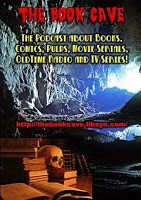


 DreamWorks Studio released details about February’s thriller I Am Number Four. Given the behind-the-scenes crew and the cast, we’re certainly intrigued. Take a look and you tell us.
DreamWorks Studio released details about February’s thriller I Am Number Four. Given the behind-the-scenes crew and the cast, we’re certainly intrigued. Take a look and you tell us. Genre: Action-thriller
Genre: Action-thriller

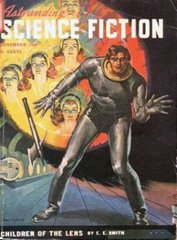


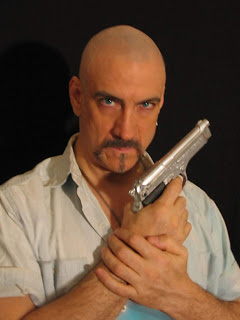


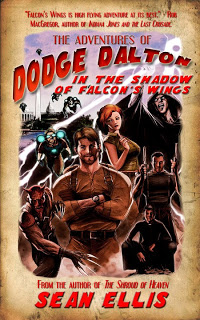





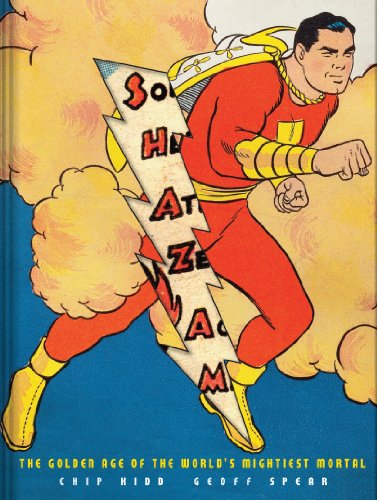 With one magic word, Billy Batson turned from a 10-year old orphan into Captain Marvel. It was a form of wish fulfillment that beat [[[Superman]]] and may well explain why Fawcett’s comics were outselling DC Comics’ Man of Steel. Maybe it was CC Beck and company’s clean, slightly cartoony style. It was probably a combination of these factors, but for a time, comics featuring Captain Marvel and his extended family were outselling Superman in his own title or [[[Action Comics]]] and [[[World’s Finest Comics]]].
With one magic word, Billy Batson turned from a 10-year old orphan into Captain Marvel. It was a form of wish fulfillment that beat [[[Superman]]] and may well explain why Fawcett’s comics were outselling DC Comics’ Man of Steel. Maybe it was CC Beck and company’s clean, slightly cartoony style. It was probably a combination of these factors, but for a time, comics featuring Captain Marvel and his extended family were outselling Superman in his own title or [[[Action Comics]]] and [[[World’s Finest Comics]]].